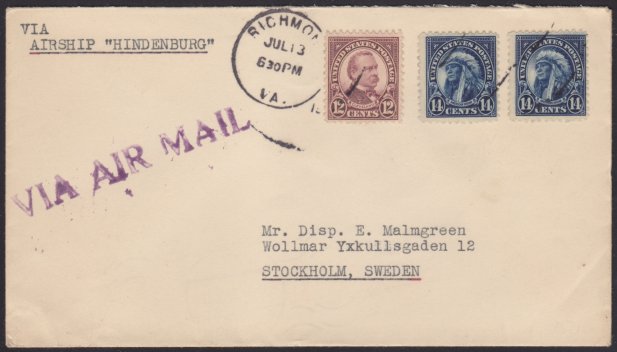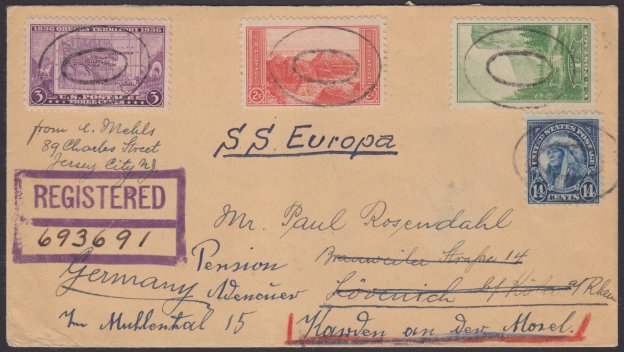United States
The American Indian stamp is arguably one of the most beautiful stamps the United States has ever issued, but its face value is something of an anomaly. As the nation’s first 14¢ postage stamp—and one of only half a dozen stamps of that value in the country’s history—it was supposedly issued to meet specific parcel post rates.1 Nevertheless, extant examples suggest the stamp was used primarily for other purposes.
When found on cover, the stamp is generally accompanied by other values that collectively make up a higher registration or airmail rate. It is unusual to find the stamp used by itself; such examples are often philatelic in nature, and commercial solo uses are very scarce.
The U.S. issued two varieties of the American Indian stamp: one printed on flat plate presses, and the other on rotary presses.
Flat plate printing
The two varieties of the American Indian stamp are most easily distinguished by their perforations. All examples from the flat plate printing are perf. 11.2 The stamp went on sale in Washington, D.C., and Muskogee, Oklahoma, on May 1, 1923.
This stamp exists in several minor variations of a deep, rich blue. That is typical for any stamp printed in significant quantities, as the color of one batch of ink may not exactly match the color of the next batch.3
Stamps from the flat plate printing were used well into the 1930s, and past the time when 14¢ stamps printed on rotary presses were introduced.
- First day cover (Washington, 1923)
- First day cover (Muskogee, 1923)
- Night Air Mail cover (1923)
- National Sugar Refining Company cover (1923)
- Elliott Perry cover (1924)
- Chicago bank cover (1924)
- Union Trust Company cover (1924)
- Los Angeles cover (1924)
- American Peace Award cover (1925)
- Clokey cover (1926)
- CAM 8 cover (1926)
- Colorado bank cover (1927)
- USS Marblehead parcel fragment (1927)
- Kelsey Press Company cover (1927)
- CAM 20 cover (1928)
- USS Maryland parcel fragment (1929)
- FAM 5 cover (flown by Charles Lindbergh, 1929)
- FAM 9 cover (Miami, Florida, to Mollendo, Peru, 1929)
- Pennsylvania cover (1930)
- Aleppo cover (1930)
- Buffalo Bill cover (1935)
- Hindenburg cover (1936)
- Indian River cover (1936)
- Dallas cover (1940)
- Souvenir Cocoanut parcel label (date unknown)
- James Manufacturing parcel tag (date unknown)
- MacWhyte parcel tag (date unknown)
Rotary printing
The Bureau of Engraving and Printing, which for decades printed U.S. postage stamps, had used rotary presses to print coil stamps as early as the 1910s. It was not until the mid 1920s, however, that sheets of the lower values of the fourth Bureau issue were produced by that method en masse, and it was not until 1931 that the American Indian stamp was printed using the rotary press.
Stamps from the rotary printing are perf. 11×10½, and the design is slightly taller than on the flat plate stamps; the difference is less than a millimeter.
Specialists will also note that stamps from the rotary press printing tend to have a slightly washed out appearance when compared with stamps from the flat plate printing; the color simply is not as stunning. Nevertheless, perforation size remains the surest and simplest means of distinguishing between the flat plate and rotary press varieties.
The perf. 11×10½ stamp went on sale in Washington on September 8, 1931, and remained in use for the balance of the decade. With the release of the 1938 presidential issue, however, the American Indian stamp was gradually phased out, and any examples postmarked after the 1930s are late usages.
- First day cover (1931)
- Oklahoma Silver Jubilee cover (1932)
- Swatow cover (1934)
- Yonkers cover (1934)
- Osage cover (1934)
- Meriwether Lewis cover (1934)
- Omaha cover (1934)
- Charles Floyd cover (1934)
- Cheyenne Agency cover (1934)
- Sacagawea cover (1934)
- Honolulu cover (1935)
- Goldwasser cover (1935)
- SS Deutschland cover (1935)
- Europa cover (1936)
- North Dakota cover (1937)
- Los Angeles cover (1937)
- Lackey cover (1937)
- Summerville parcel fragment (1937)
- Berkeley cover (1937)
- Fibreboard Products cover (1937)
- St. Paul Casket Company cover (1938)
- First day cover (1938)
- Copenhagen cover (1938)
- Big Indian cover (1938)
- Vienna cover (1938)
- DAR parcel fragment (date unknown)
References
- United States Post Office Department. Annual Report of the Postmaster General. Washington: Government Printing Office, 1922. Accessed 12 Oct. 2010.
- Kloetzel, James, ed. Scott 2010 Specialized Catalogue of United States Stamps & Covers. Sidney, Ohio: Scott Publishing Co., 2009.
- Cabeen, Richard McP. Standard Handbook of Stamp Collecting. 2nd ed. New York: Thomas Y. Crowell Co., 1965.
Published 2018-06-17 Last updated 2025-02-01

